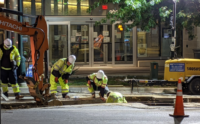Maryland transportation officials have chosen a private consortium to design, build, operate, maintain and partially finance the 16.2-mile Purple Line light-rail line across the northern Washington, D.C., suburbs.
The selection of Purple Line Transit Partners—led by Fluor Enterprises Inc., P3 equity investment firm Meridiam and public infrastructure management company Star America—followed months of negotiations aimed at reducing the state’s financial contribution to the $5.6-billion project. Maryland now will pay $3.3 billion over the 36-year contract, which includes a six-year construction phase, slated to begin later this year, with full operation scheduled for 2022.
A combination of increased local funding, low interest rates, and changes to design specifications and operational strategies helped to reduce Maryland’s upfront obligation to $159.8 million from $700 million while cutting the state’s average annual availability payment over the 30-year operational period by $18 million, to $149 million. According to the state, the Purple Line’s anticipated overall cost is now $550 million less than original estimates.
Montgomery and Prince George’s counties, which will be served by the Purple Line, are contributing a total of $330 million in cash and land for the project, which also has been approved for $900 million in federal New Starts Funding. Montgomery County recently was asked to add another $13.8 million for elevators, to connect the Purple Line’s western terminus in Bethesda with an existing subway station.
The Purple Line’s railcars are to be supplied by Spain’s CAF, which has been criticized for delayed deliveries and equipment malfunctions in other transit projects. To address these issues, Maryland transportation officials say that, should those issues occur, the Purple Line contract includes penalties.
Once complete, the 21-station Purple Line will be the first non-highway-based transit system to connect key spokes of the D.C. area’s Metrorail system.
The remaining procedural steps include the expected approval by the Maryland Board of Public Works on April 6 and financial close in early June. The Maryland Transit Administration will oversee construction.






